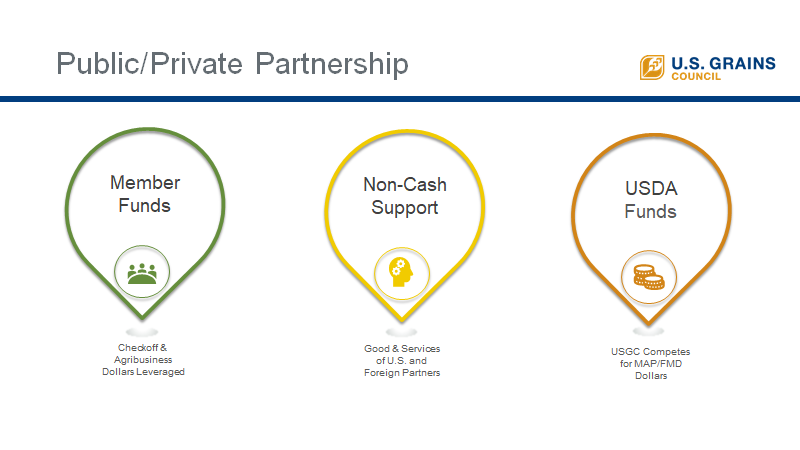Six decades of the U.S. Grains Council’s (USGC’s) successful work building markets for U.S. coarse grains and co-products around the world can be attributed largely to the strong public-private partnership driving the organization’s efforts. With resources from the U.S. Department of Agriculture (USDA), commodity organizations representing corn, sorghum and barley industries, and agribusiness members, the Council can identify short-term demand opportunities, defend against market access challenges and turn potential demand into realized exports.
“As the Council looks to aggressively pursue opportunities, we need the robust engagement of our members,” said Ellen Zimmerman, USGC director of industry relations. “With the support of our funding partners, the Council has been able to pivot programming to meet demand needs and global challenges like COVID-19 to keep doing what our staff does best – develop markets, enable trade and improve lives.”
Two long-term government initiatives form the backbone of this support – the Market Access Program (MAP) and Foreign Market Development (FMD) program – both funded through the farm bill. Both programs augment base funding provided by the commodity checkoff programs to establish long-term presence in world markets, promote U.S. agricultural products and bring together groups of prospective buyers with producers in the United States.
MAP and FMD have successful track records in generating a high return on investment for both farmer and federal dollars. According to a cost-benefit analysis conducted by Informa Economics in 2016, the value of U.S. agricultural exports increased $24 for every $1 invested between 2002 and 2014. Additionally, MAP and FMD account for 15 percent of revenue generated between 1977 and 2014 through U.S. agricultural exports – $309 billion in total.
In addition to these core sources of funding, the Council seeks opportunities to further enhance market development opportunities through other programs. Notably, the Agricultural Trade Promotion (ATP) program, started in 2019, helped expand the organization’s global footprint, stimulate new demand in existing and untapped grains markets, and explore new approaches to value-added products.
Other programs have more narrow areas of focus. The Emerging Markets Program (EMP), State Department grants, Sec. 108 program and other programs have allowed the Council to pursue projects not possible within the regular budget.
The core of this support comes from base funding provided by checkoff organizations. These grower organizations bolster the Council’s work by helping cover fixed operating costs, human resources and general operations. Additional grants from farmer members are used for administrative operations and to cover shifts in the Council’s programming to newer areas of promotion, especially ethanol export market development.
“Member funds, along with non-cash support, allow us to match and make the most of USDA funds,” Zimmerman said. “We are grateful for our longstanding partnerships and look forward to continuing these efforts in 2021 and beyond.”
About The U.S. Grains Council
The U.S. Grains Council develops export markets for U.S. barley, corn, sorghum and related products including distiller’s dried grains with solubles (DDGS) and ethanol. With full-time presence in 28 locations, the Council operates programs in more than 50 countries and the European Union. The Council believes exports are vital to global economic development and to U.S. agriculture’s profitability. Detailed information about the Council and its programs is online at www.grains.org.

